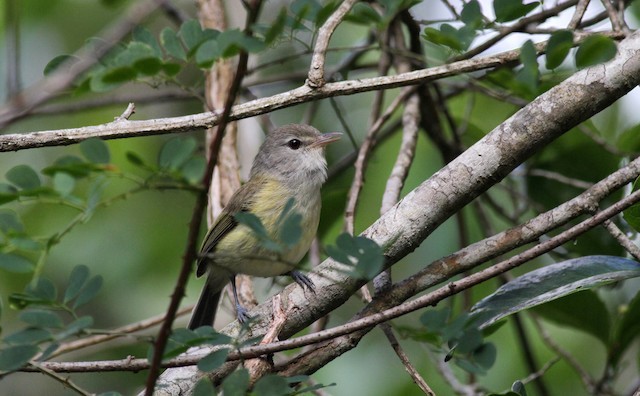Birdfinding.info ⇒ Easy to find in the western state forests: Guánica, Maricao, Río Abajo, Guajataca, and Cambalache. In the San Juan area, Piñones State Forest seems to be the most reliable site. Also occurs in El Yunque National Forest, but not common there.
Puerto Rican Vireo
Vireo latimeri
Endemic to Puerto Rico, where it is widespread in woodlands and scrub at all elevations. Common on the western half of the island in both wet and dry habitats; uncommon and localized on the eastern half.
Identification
A small, indistinctly marked vireo with an olive back, grayish head, mostly yellowish underparts, and a pinkish bill. Usually best located and identified by voice.
The vividness of its coloration varies widely. Some individuals are drab and indistinctly colored, with pale, whitish underparts. Others are bright yellow below and have a strongly contrasting gray or brownish hood.
Facial markings also vary: most show a broken white eyering (crescents above and below the eye). Some have stronger markings: a short whitish eyebrow, accented by a subtle eyeline. Some appear to lack facial markings altogether.
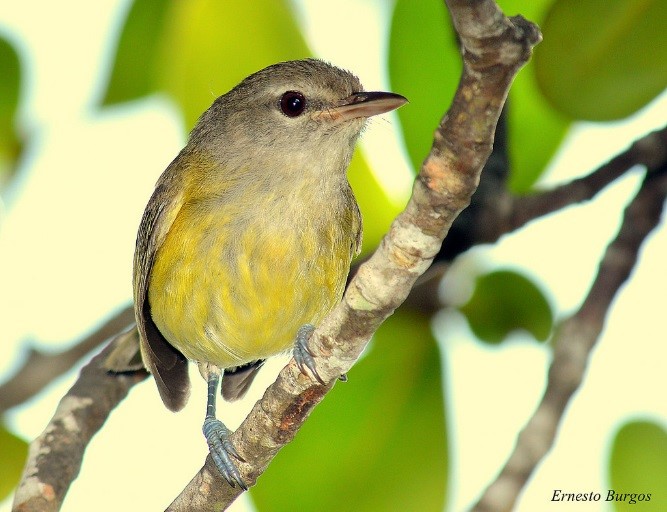
Puerto Rican Vireo. (Maricao State Forest, Puerto Rico; May 19, 2014.) © Ernesto Burgos

Puerto Rican Vireo, with white throat and yellow breast in unusually strong contrast. (Lago Carite, Puerto Rico; November 28, 2015.) © William Rios-Maldonado
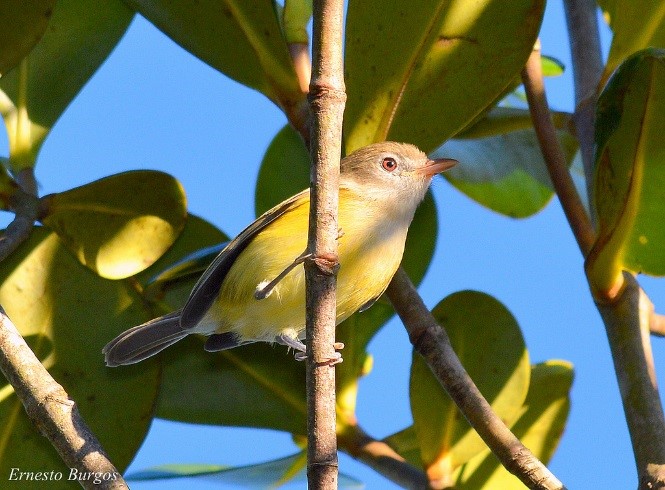
Puerto Rican Vireo, with the eye fully illuminated. (Maricao State Forest, Puerto Rico; November 9, 2013.) © Ernesto Burgos
Potentially confused with the female or immature plumages of several North American songbirds that migrate through the Caribbean, including Philadelphia Vireo and Connecticut and Nashville Warblers (see below). In some individuals, plumage alone may be ambiguous, and it can be difficult to see well, so voice is generally its key characteristic.
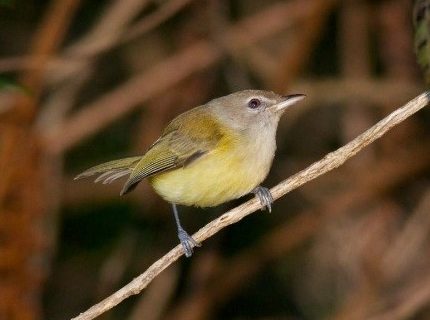
Puerto Rican Vireo—note the resemblance to Connecticut Warbler, which migrates through its range. (Maricao State Forest, Puerto Rico; March 16, 2012.) © Paul A. Guris

Puerto Rican Vireo. (Cambalache State Forest, Puerto Rico; February 18, 2009.) © Ernesto Burgos
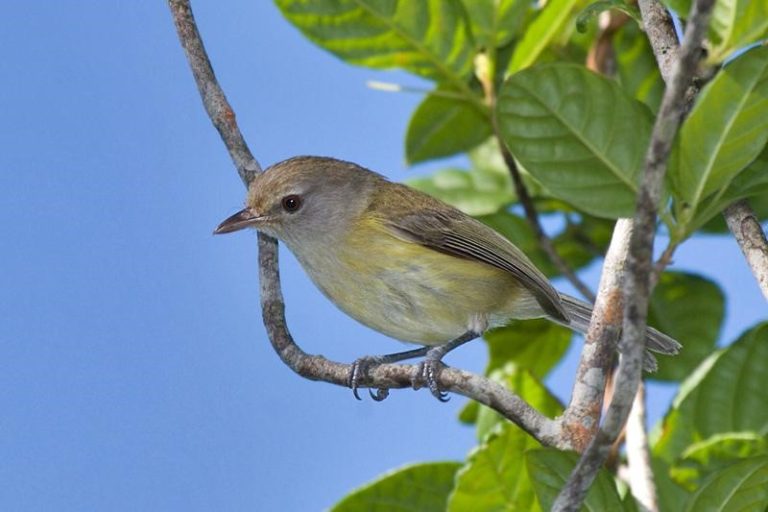
Puerto Rican Vireo, a pale, drab individual. (Maricao State Forest, Puerto Rico; May 17, 2009.) © Kristof Zyskowski
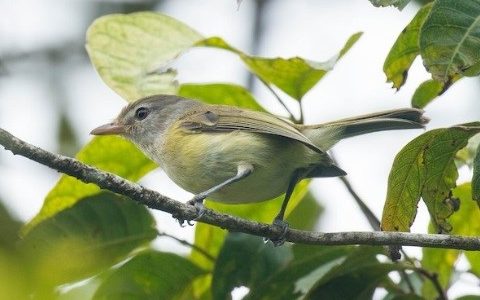
Puerto Rican Vireo. (Maricao State Forest, Puerto Rico; March 24, 2017.) © Nick Dorian

Puerto Rican Vireo. (Maricao State Forest, Puerto Rico; July 29, 2013.) © Michael McCloy

Puerto Rican Vireo, a bright yellow individual with pronounced facial markings and notable resemblance to Philadelphia Vireo. (Maricao State Forest, Puerto Rico; February 6, 2009.) © Ernesto Burgos

Puerto Rican Vireo, a bright yellow individual. (Maricao State Forest, Puerto Rico; February 6, 2009.) © Ernesto Burgos
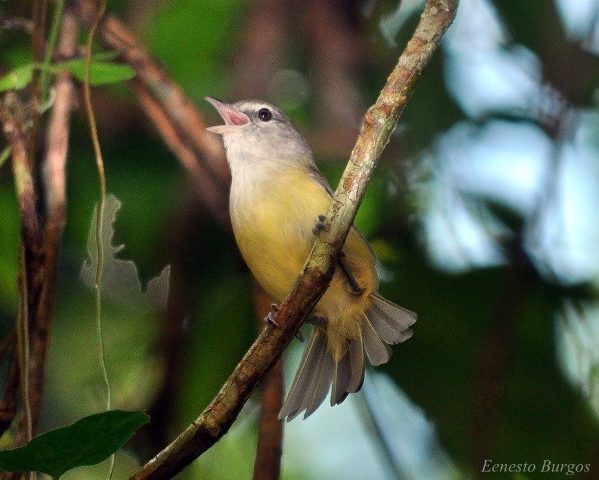
Puerto Rican Vireo, singing. (Cambalache State Forest, Puerto Rico; February 18, 2009.) © Ernesto Burgos

Puerto Rican Vireo. (Maricao State Forest, Puerto Rico; May 19, 2014.) © Ernesto Burgos
Cf. Philadelphia Vireo. Individual Puerto Rican Vireos that have pronounced facial markings can resemble Philadelphia Vireo, though Philadelphia has a yellower throat, fuller, whiter eyebrow and darker, more pronounced eyeline.
Cf. Connecticut Warbler. Individual Puerto Rican Vireos that have faint facial markings can strongly resemble Connecticut Warbler (especially the female plumage), which migrates across the eastern Caribbean in both spring and fall, and is increasingly being detected in Puerto Rico. Connecticut Warbler has pink legs, whereas the vireo’s legs are dark gray.
Cf. Other Warblers. Female Mourning Warbler, a rare fall vagrant on Puerto Rico, is also similar, but usually shows no eyering—however, its sibling species, MacGillivray’s Warbler, of western North America, has eye-crescents much like the vireo’s. Like Connecticut, these species have pink legs, but are otherwise extremely similar to Puerto Rican Vireo.
Female and immature Nashville Warbler also have very similar plumage and dark gray legs, but differ from Puerto Rican Vireo in having a much thinner, sharper-tipped, all-dark bill.
Notes
Monotypic species.
References
Brewer, D. 2017. Puerto Rican Vireo (Vireo latimeri). In Handbook of the Birds of the World Alive (J. del Hoyo, A. Elliott, J. Sargatal, D.A. Christie and E. de Juana, eds.). Lynx Edicions, Barcelona. https://www.hbw.com/node/61248. (Accessed November 8, 2017.)
eBird. 2018. eBird: An online database of bird distribution and abundance. Cornell Lab of Ornithology, Ithaca, N.Y. http://www.ebird.org. (Accessed November 10, 2018.)
Raffaele, H. 1989. A Guide to the Birds of Puerto Rico and the Virgin Islands. Princeton University Press, Princeton, N.J.
Raffaele, H., J. Wiley, O. Garrido, A. Keith, and J. Raffaele. 1998. A Guide to the Birds of the West Indies. Princeton University Press, Princeton, N.J.
Roach, M. 2013. Puerto Rican Vireo (Vireo latimeri), version 1.0. In Neotropical Birds Online (T.S. Schulenberg, ed.). Cornell Lab of Ornithology, Ithaca, New York. https://doi.org/10.2173/nb.purvir1.01.
